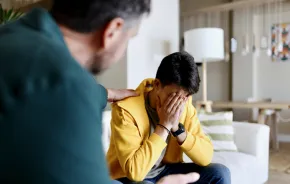
Editor's note: This article was sponsored by Seattle Children's Hospital.
Experiencing physical pain and suffering can have a long-lasting impact on a child, says professor Gary Walco, Ph.D., the director of pain medicine at Seattle Children’s Hospital.
That’s why it’s so important to help children address both the physical and psychological components of pain.
“Parents should look to prevent and treat pain to the extent possible,” says Walco. “Yes, you’re going to feel pain in your life. The question is: Can you keep the pain to a minimum?”
More than 20 percent of children and adolescents worldwide experience some chronic pain, such as headaches, musculoskeletal pain or abdominal pain, studies estimate. Even more experience intermittent pain, from the pangs of broken bones to the prick of a vaccination needle. Parents can play a critical role by effectively addressing their child’s pain at home and by working with medical providers to create appropriate pain-reduction strategies.
September is Pain Awareness Month, a designation that the International Association for the Study of Pain says can help focus attention on pain, its causes and the latest advances in its treatment.
“This is an issue worthy of attention and prevention,” says Walco.
Why we treat pain
Pain serves an important role as a warning system. If you’re touching something hot, you don’t want it to burn you. Similarly, if you twist an ankle, pain creates a signal not to put any additional pressure or weight on the injury.
Once that warning signal is recognized, however, there is no need for unnecessary suffering, Walco says. In fact, left untreated, pain can lead to lasting consequences, especially in children whose nervous systems are still developing.
That’s because many parts of the central nervous system are involved in the body’s complex response to pain. In young patients, untreated pain can potentially alter the body’s processing for years to come, he notes. For example, imagine a baby admitted to the Neonatal Intensive Care Unit who experiences repeated blood draws with a heel stick. If the pain of those pricks isn’t addressed, the heel itself could be sensitive for months. The repercussions could also spread beyond the heel, making the developing nervous system more sensitized to pain overall, says Walco.
Along with the physical implications, there are behavioral reasons to reduce pain as well. Fear of needles can prevent people from accessing important preventative medicine, such as blood tests or immunizations. About 16 percent of the adult population avoids receiving the annual flu vaccine because they dislike needles, according to the findings in one review. Often, this aversion stems from unpleasant childhood encounters.
“All it takes is one bad experience and you set someone on a course that’s potentially really problematic,” says Walco.
Addressing vaccination pain
Childhood immunizations can be a source of understandable stress and anxiety for children — and for their parents. But addressing vaccination pain can be as simple as applying a local anesthetic to numb the site of the injection, Walco says.
If you’re taking your child in for an immunization, check to see if the provider will be using topical lidocaine. If that’s not offered, ask where on the body the shot will be administered. Then, consider applying an over-the-counter topical ointment containing lidocaine to your child’s skin just prior to the appointment.
Other strategies that can help reduce vaccination-related pain include skin-to-skin contact, breastfeeding or providing sucrose to young children during the injection. Comfortable positioning as well as distracting your child by stroking their hair or softly singing to them may help, too.
“All of these things will make the experience more tolerable,” says Walco.
A parent’s calm demeanor can also positively influence how a child copes with pain. And, if a situation does spiral out of control — say, your child begins kicking and screaming to resist a vaccination or procedure — don’t attempt to pin them down.
“This completely reinforces the aversion,” says Walco. “No one likes to feel overpowered.”
Asking questions, advocating appropriately
Parents are in the best position to advocate for their child and to make sure steps are taken to prevent their child’s suffering from pain and offer comfort — in any medical setting and at home — Walco says.
If a child has a planned surgery, it’s reasonable to discuss in advance how the medical team plans to address the young patient’s postoperative pain. And, if your child unexpectedly winds up in the emergency room, ask the provider about how their pain will be managed.
“It’s extremely appropriate for parents to advocate and ask that question,” says Walco.
Apart from helping your child navigate such an experience (whether it is expected or not), your calm advocacy will help reduce the chances that they will become distressed and anxious during future medical visits.
Not just medicine
Medicine isn’t the only way to address pain. There are plenty of social and physical ways of reducing discomfort, many of which a parent does naturally.
For example, if a child bumps their head and starts crying, you’re likely to stroke them, soothe them and then help them move on. A parent might acknowledge the pain and then distract the child.
“You want children to try and understand that ‘Yes, this hurt, but you can master the situation and cope with it,’” says Walco.
Avoid shaming a child into ignoring pain, though, Walco advises. That means no “Be a big kid and don’t cry” comments. Likewise, refrain from drawing comparisons to other children who handle pain differently (read: more stoically), he advises.
Along with verbal affirmation, guidance and comfort, there’s also been research on the use of other strategies for addressing pain. Biofeedback and hypnosis have been shown to be effective ways to treat headaches and other pain concerns. Acupuncture may also be incorporated into a child’s pain treatment plan at Seattle Children’s.
No place for grit
Like most experiences, a child’s temperament plays a sizable role in what pain treatment strategies will work best. For example, a highly sensitive child might experience and cope with pain differently.
When trying to gauge your child’s experience of pain, Walco isn’t inclined to ask a child to quantify it, such as by assigning numbers. Instead, he prefers to ask open-ended questions to gather information, such as: “Tell me what you’re feeling. Where does it hurt? What does that feel like? What do you think we should do to make it better?”
So, what about all of that parenting advice about raising kids to “tough it out” with resilience and grit?
Pain is a very poor tool to be used in cultivating those skills, Walco warns.
“If you’re going to use coping with pain to help build character in your child, you need to pause and think about your priorities as a parent,” he says. “I see very little to no value in unnecessary suffering.”
|
Sponsored by: |












